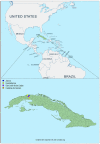Detection, Characterization and Sequencing of BTV Serotypes Circulating in Cuba in 2022
- PMID: 38275974
- PMCID: PMC10819738
- DOI: 10.3390/v16010164
Detection, Characterization and Sequencing of BTV Serotypes Circulating in Cuba in 2022
Abstract
In Cuba, despite a high sero-prevalence of bluetongue virus (BTV), circulating serotypes remain unknown. The aim of this study was to identify circulating BTV serotypes in farms throughout the western region of Cuba. Blood samples were collected from 200 young cattle and sheep between May and July 2022 for virological analyses (PCR, viral isolation and virus neutralization) and genome sequencing. The results confirmed viral circulation, with viro-prevalence of 25% for BTV. The virus was isolated from 18 blood samples and twelve BTV serotypes were identified by sequencing RT-PCR products targeting the segment 2 of the BTV genome (BTV-1, 2, 3, 6, 10, 12, 13, 17, 18, 19, 22 and 24). Finally, the full genome sequences of 17 Cuban BTV isolates were recovered using a Sequence Independent Single Primer Amplification (SISPA) approach combined to MinION Oxford Nanopore sequencing technology. All together, these results highlight the co-circulation of a wide diversity of BTV serotypes in a quite restricted area and emphasize the need for entomological and livestock surveillance, particularly in light of recent changes in the global distribution and nature of BTV infections.
Keywords: BTV; Nanopore sequencing; PCR; Sanger; isolation; serotypes.
Conflict of interest statement
The authors declare that they have no conflicts of interest.
Figures



References
-
- International Committee on Taxonomy of Viruses. [(accessed on 8 November 2022)]. Available online: https://ictv.global/report/chapter/sedoreoviridae/sedoreoviridae/orbivirus.
-
- Walton T.E. The history of bluetongue and a current global overview. Vet. Ital. 2004;40:31–38. - PubMed
-
- WOAH-Listed Diseases. [(accessed on 6 August 2021)]. Available online: https://www.woah.org/en/what-we-do/animal-health-and-welfare/animal-dise...
-
- Acevedo A.M., Hinojosa Y., Relova D., Perera C.L. Bluetongue virus: A known virus, a current threat. Rev. Salud Anim. 2016;38:52–59.
MeSH terms
Grants and funding
LinkOut - more resources
Full Text Sources

